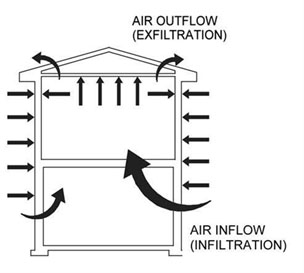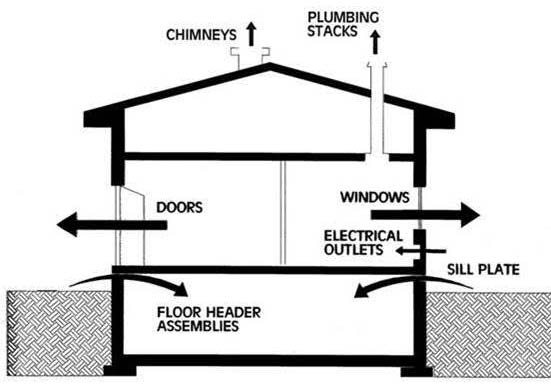
Photo by Bernard Spragg
What is building science?
Building science is based on an understanding of current scientific knowledge and experience that focuses on alleviating how the elements, such as weather and subterranean conditions, affects homes and buildings including ways of conserving energy. Every aspect of building science focuses on analyzing and controlling the factors and conditions that contribute to the deterioration of structural integrity, energy conservation and the factors that affect the health and well-being of building occupants. This encompasses everything from building materials to the architectural design and guidelines used to create structures. The goal of building science is to optimize, improve and enhance overall building performance.
Building Science is a Massive Subject
Solutions that address building science concerns are comprised of a multitude of specialization areas—from academic and research studies to architectural design to material and product manufacturing and applications in the field. Individuals can become degreed in Building Science, however; to date there is no specific Building Science certification. Contractors in the U.S. can be certified by the BPI (Building Performance Institute), but that certification does not qualify them as “Building Scientists”. Understanding building science and creating building science solutions is such a massive topic that no single entity can realistically address it all. Therefore, many specializations and innovations are needed to provide viable, effective and long-lasting remedies.
The Two Major Components of Building Science

Illustration Courtesy of airbarrier.org
The two major components of building science are the building enclosure, or envelope, which separates the outdoors from the indoors and the internal environment that directly impacts the air-quality, health, safety and comfort of the building’s occupants. However, the building’s occupants are also affected by external environmental factors, such as temperature, solar rays, noise, etc. and their ability to control these influences. It’s important to understand that no single part of a home or building is an isolated system. Think of it as an integrated system in which all the parts affect, and are affected by, each other which in turn is affected by an external environment. Everything is related in one way or another. Yes, it’s mind-boggling.
Air Flow is Everything

Illustration Courtesy of airbarrier.org
Understanding air flow means knowing where air leaks are likely to be found so they can be controlled or eliminated. Air leaks alter the temperature of the internal environment and carry moisture, mold, pollen and other pollutants that affect the occupants. The goal is to increase energy efficiency and comfort and reduce or eliminate pollutants. Every aspect of a structure has the potential for leakage: ceilings, walls, roofs, attics, basements, crawl spaces, HVAC systems, chimneys, recessed lighting, vents, soffits, chases, doors, windows, and anywhere else that internal and external environments meet. Keeping up with energy codes in your state is important. Building codes can be found at the DOE (the US Department of Energy).
Your Specialization is Important
So, how does one tackle the massive undertaking of understanding building science? It’s all about knowing your area of specialization well and the parts of the system could impact it. For example, you would never hire a plumber to fix your air conditioner. However, plumbing is required for the air conditioner to operate. Furthermore, electricity is necessary for air conditioning to work too. So, these parts work together to produce the desired outcome—a working air conditioner. But, hold on, the goal should be more than just making the air-conditioner operate, it needs to operate efficiently. This means that the environment that the air-conditioner is cooling also needs to be improved to make the air conditioner operate more efficiently. If the windows and doors in the building are allowing warm air to enter, improving the air conditioner itself is only one part of the solution. The air conditioner operates as an integrated system—not as an isolated object.
How Does Understanding Building Science Impact You?
Understanding building science is vital for every person or industry associated with improving building performance. Since no one person can do it all or know it all, specialization is, and has been, key in addressing building science issues. Solutions are constantly being sought after to make products, services and application better and better. The more you understand building science as systems of operations, the better you and your company can be positioned to professionally address building performance issues and requirements. And, the better you will be able to cultivate and educate customers as to how your specialization plays an important role in improving things like structural integrity, energy conservation, savings, comfort, health, well-being and quality of life.
One Size Does Not Fit All
When it comes to materials and application approaches, one size does not fit all. If you’re a contractor who works in different climate zones, there are a whole host of environmental considerations to be aware of for a successful application. Hot, humid climates may require a different approach, materials and applications methods than those that work in cooler, less humid climates. Wind, temperature and humidity affect the applicator’s ability to apply spray foam to roofs or other exterior sections of the building envelope. Weather conditions need to be continuously monitored for a successful application, especially because it can interfere with the application process and the ability to complete deadlines on time.
Terms Can be Confusing
There is often lot of confusion among terms. An example are the terms “air barrier” and “vapor barrier”. Air barriers systems address air-transported moisture whereas vapor barriers systems address vapor diffusion—the movement of water vapor through a porous material. Vapor diffusion occurs when concentrations of a gas or vapor flow from areas of high concentration to low concentration. An example would be opening a can of soda. Carbon dioxide bubbles diffuse into the air and eventually the soda becomes flat. The carbon dioxide gas went from a state of high concentration to a state of low concentration as it diffused out of the soda. Systems developed to control vapor diffusion are referred to as Vapor Retarders.
How Your Area of Specialization Can Thrive
The key to company success is to learn more how your specialization is affected by other specializations and how those specializations impact your product or application’s performance. If you’re dealing with older construction, you must also consider how old fixes, and applications will affect your product’s performance. Older substances may have to be completely removed and the surfaces prepped to make your application more successful. What if you can’t remove the old to install the new? Time to consult an expert, so have a list of resources ready so you can ask these important questions.
It’s no stretch of the imagination to think about the merging of specializations that overlap or complement each other. Company mergers create a wider opportunity to offer a more encompassing service than single specialization can offer. This company would now have a broader understanding of, and more expertise for, a larger part of the system. This is the same reason that we find banks inside grocery stores or restaurants inside retail stores.
Learn a Little Each Day
Make learning building science manageable. Take it upon yourself to learn a little more each day about how other specializations affect your application or installation. Watch Youtube videos or read a few articles for quick overview. A better understanding of how your specialization integrates as a system cannot only bring you more business, it can bring you a lot more opportunity to improve what you do and become better than the competition. It’s never too late to learn more about building science. Continuously strive to improve on your company’s specialization, and never be too busy to learn more about building science. It will pay off!
Look for more Building Science articles to come on Sprayfoaminsider.com.





